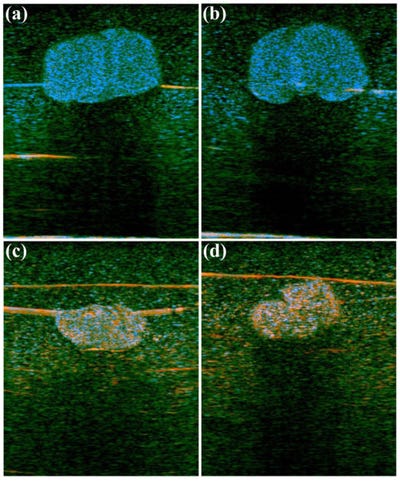New Color Format Could Boost Ultrasound
November 2, 2016
University of Rochester researchers have incorporated new color identifications to ultrasound images, providing clarity to previously indistinguishable objects.
Kristopher Sturgis
 A new imaging format for ultrasound machines uses a set of mathematical functions to integrate color identifications so that doctors differentiate between muscle, veins, arteries, and other soft tissue, according to the University of Rochester researchers who created the new format.
A new imaging format for ultrasound machines uses a set of mathematical functions to integrate color identifications so that doctors differentiate between muscle, veins, arteries, and other soft tissue, according to the University of Rochester researchers who created the new format.
The new format could represent an improvement over traditional ultrasound images, in which details can show up as indistinguishable objects in various shades of grey.
Kevin Parker, University of Rochester engineering professor and lead author on the work, says that the new technology can be easily integrated into existing ultrasound machines on various platforms, and can have a significant impact on diagnosing a range of different conditions.
"These can be implemented in the signal processing chain of the scanner, and we've already tested this on scans from four different platforms," he says. "I hope this will help to more clearly and quickly diagnose a range of different conditions that are currently ambiguous on ultrasound images and other modalities."
In the past few months we've seen a few different iterations of ultrasound technologies pave the way for creative new medtech solutions. Last month researchers from UCLA produced a study that aims to use ultrasound techniques to wake coma patients--a method that uses sonic stimulation to excite the neurons in the brain via the thalamus. Elsewhere, researchers from the University of Pittsburgh have begun to devise a method that combines ultrasound energy with microbubbles in an effort to create new cancer therapies.
Parker's new technique actually takes advantage of a set of mathematical functions devised in 1890 by the great mathematician Charles Hermite. Parker says that he essentially stumbled on the functions when doing research for a separate project and instantly noticed a connection to the pulses of ultrasound waves.
"I was searching a large compilation of math functions for help with another ultrasound project, and happened to see some of the Hermite functions," he said. "I was struck by how similar they are to many ultrasound pulses, and their very elegant and useful properties."
Parker says the functions make their analysis of ultrasound scattering easier. Instead of viewing images that show all of the various tissue structures as indistinguishable black and white objects, they can now classify them mathematically by size, and then assign unique colors to each unique type of scatterer.
As the group moves forward with their research, Parker says they've begun to collaborate with the university's technology transfer office to secure a provisional patent on the technology, called the H-scan. He's hoping that companies will eventually be able to license the H-scan and begin to seamlessly integrate it into ultrasound platforms to begin clinical trials.
"For now, the plan is to test it on different clinical studies, both human and animal," Parker says. "The basic technology is ready to go. A key step is to get it implemented into a clinical scanner, and then have expert clinicians use it on selected patients to obtain preliminary data."
Kristopher Sturgis is a contributor to Qmed.
Like what you're reading? Subscribe to our daily e-newsletter.
About the Author(s)
You May Also Like

.png?width=300&auto=webp&quality=80&disable=upscale)
